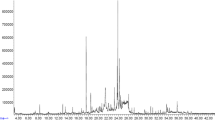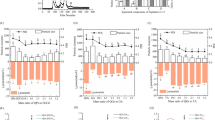Abstract
Autooxidation of five polyphenols representing range of different hydrophobicities (catechin gallate (CG), (-) catechin((-)C), epicatechin (EC), epigallocatechin gallate (EGCG) and epigallocatechin (EGC)) in three different aqueous solutions: molecular solution, micellar solution (Tween-20) and liposomal dispersion (soybean lecithin) was monitored by HPLC. The rate of oxidation of the five polyphenols was higher at pH 4.5 than at pH 3.5. Compared with the control, addition of Tween-20 (micellar structure) and lecithin (liposomal structure) significantly decreased the degradation of polyphenols. In the presence of lecithin the autooxidation of all the five polyphenols was slower than in the presence of Tween-20. The effective protection of the colloidal structures was compared with the hydrophobicity of the polyphenols estimated from the partitioning between octanol and water. The protection from oxidation in the presence of the colloidal structures (micellar or liposomal) increased with increasing partitioning of a polyphenol towards the hydrophobic environment. The protecting effect of the colloidal structures was more effective at pH 4.5 than at pH 3.5.
Similar content being viewed by others
References
Wang H, Cao G H, Prior R L. Total antioxidant capacity of fruits. J Agric Food Chem, 1996, 44(3): 701–705
Ock-Sook Y, Meyer A S, Frankel E N. Antioxidant activity of grape extracts in a lecithin liposome system. JAOCS, 1997, 74(6): 1301–1306
Cheynier V, Basire N, Rigaud J. Mechanism of trans-caffeoyltaric acid and catechin oxidation in model solution containg grape polyphenoloxidase. J Agric Food Chem, 1989, 37(4): 1069–1071
Risch B, Herrmann K. Contents of hydroxycinnamic acid derivatives and catechins in pome and stone fruit. Z Lebensm Unters Forsch, 1988, 186: 225–230
Czochanska Z, Lai Y F, Newman H, et al. Polymeric proanthocyanidins. Stereochemistry, structural units, and molecular weight. J Chem Soc, 1980, Perkin I: 2278–2285
Kim D O, Jeong S W, Lee C Y. Antioxidant capacity of phenolic phytochemicals from various cultivars of plums. Food Chem, 2003, 81(2): 321–326
Chun O K, Kim D-O, Lee C Y. Superoxide radical scavenging activity of the major polyphenols in fresh plum. J Agric Food Chem, 2003, 51(27): 8067–8072
Doll R. An overview of the epidemiological evidence linking diet and cancer. Proc Nutr Soc, 1990, 49(1): 119–131
Ames B M, Shingena M K, Hagen T M. Oxidants, antioxidants and the degenerative diseases of aging. Proc Natl Acad Sci USA, 1993, 90(11): 7915–7922
Dragsted L O, Strube M, Larsen J C. Cancer-protective factors in fruits and vegetables: Biochemical and biological background. Pharmacol Toxicol (Suppl. 1), 1993, 72(1): 116–135
Sun J, Chu Y F, Wu X, et al. Antioxidant and antiproliferative activities of common fruits. J Agric Food Chem, 2002, 50(25): 7449–7454
Chun O K, Kim D O, Smith N, et al. Daily consumption of phenolics and total antioxidant capacity from fruit and vegetables in the American diet. J Sci Food Agric, 2005, 85(10): 1715–1724
Armstrong B K, Mann J I, Adelstein A M, et al. Commodity consumption and ischemic heart disease mortality, with special reference to dietary practices. J Chron Dis, 1975, 28(2): 455–469
Mathew A G, Parpia H A B. Food browning as a polyphenol reaction. Adv Food Res, 1971, 19(1): 75–145
Young D A, Young E, Roux D G, et al. Synthesis of (+)-catechin and (+)-mesquitol, conformation of bis (+)-catechins. J Chem Soc, Perkin Trans, 1987, 1: 2345–2351
Jensen O N, Pedersen J A. The oxidative transformation of (+)-catechin and (-) epicatechin as studied by ESR. Tetrahedron Lett, 1983, 39: 1609–1615
Goodenough P W, Kessell S, Lea A G H, et al. Mono-and diphe-nolase activity from fruit of Malus pumila. Phytochemistry, 1983, 22(2): 359–363
Rouet-Mayer M A, Ralambosa J, Philippon J. Roles of o-quinones and their polymers in the enzymic browning of apples. Phytochemistry, 1990, 29(2): 435–440
Oszmianski J, Lee C Y. Enzymatic oxidative reaction of catechin and chlorogenic acid in a model system. J Agric Food Chem, 1990, 38(5): 1202–1204
Guyot S, Cheynier V, Souquet J M, et al. Influence of pH on the enzymatic oxidation of (+)-catechin in model systems. J Agric Food Chem, 1995, 43(9): 2458–2462
Weinges K. Enzymatische dehydrierung des(+)-catechins. Acta Phys Chim, Debrecen, 1971, 15(1): 265–272
Richard-Forget F C, Gauillard F. Oxidation of chlorogenic acid, catechins, and 4-methyl catechol in model solution by combinations of pear (pyrus communis Cv. Williams) polyphenol oxidase and peroxidase: A possible involvement of peroxidase in enzymatic browning. J Agric Food Chem, 1997, 45(7): 2472–2476
Larsson K. Lipids-molecular Organization. Physical Functions and Technical Applications. Dundee: The Oily Press, 1994
Laha S, Luthy R G Effect of nonionic surfactants on the solubilization and mineralization of phenanthrene in soil-water systems. Biotechnol Bioeng, 1992, 40(4): 1367–1380
Bergenståhl B, Fontell K. Phase equilibria in the system soybean lecithin/water. Prog Coll Pol Sci S, 1983, 68(1): 48–52
Cheynier V, Osse C, Rigaud J. Oxidation of grape juice phenolic compounds in model solutions. J Food Sci, 1988, 53(5): 1729–1732
Paganga G, Al-Hashim H, Khodr H, et al. Mechanisms of antioxidant activities of quercetin and catechin. Redox Rep, 1996, 2: 359–364
Hou W C, Lin R D, Lee T H, et al. The phenolic constituents and free radical scavenging activities of Gynura formosana Kiamnra. J Sci Food Agric, 2005, 85(4): 615–621
Inoue K C, Murayama S H, Seshimo F M, et al. Identification of phenolic compound in manuka honey as specific superoxide anion radical scavenger using electron spin resonance (ESR) and liquid chromatography with coulometric array detection. J Sci Food Agric, 2005, 85(5): 872–878
Cogan U, Shinitzky M, Weber G, et al. Microviscosity and order in the hydrocarbon region of phospholipid and phospholipid-cholesterol dispersions. Biochemistry, 1973, 12(2): 521–527
Victoria E J, Barber A A. Peroxidation of microsomal membrane protein-lipid complexes. Lipids, 1969, 4(2): 582–588
Pryor W A, Smith K. The viscosity dependence of bond homolysis. A qualitative and semiquantitative test for cage return. J Am Chem Soc, 1970, 92(12): 5403–5405
Author information
Authors and Affiliations
Corresponding author
Rights and permissions
About this article
Cite this article
Lin, Q., Wang, J., Qin, D. et al. Influence of amphiphilic structures on the stability of polyphenols with different hydrophobicity. SCI CHINA SER B 50, 121–126 (2007). https://doi.org/10.1007/s11426-007-0009-9
Received:
Accepted:
Issue Date:
DOI: https://doi.org/10.1007/s11426-007-0009-9




